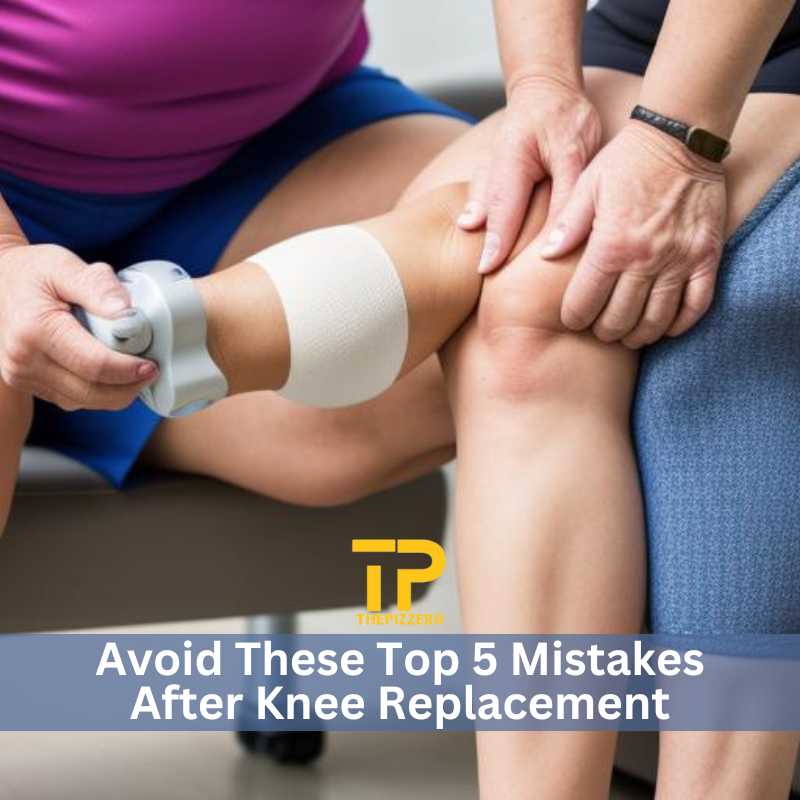Avoid These Top 5 Mistakes After Knee Replacement

top 5 mistakes after Knee Replacement
Imagine yourself staring at the pre-surgery paperwork, a mix of excitement and apprehension bubbling in your gut. You’ve finally decided on knee replacement surgery, a decision promising relief from chronic pain and a return to an active life. But along with that hope comes a wave of questions: What should I expect after surgery? Will the pain be unbearable? Are there limitations I’ll have to live with forever?
Rest assured, you’re not alone in these anxieties. Knee replacement surgery is a life-changing procedure, and navigating the recovery process can feel daunting. However, with the right preparation and knowledge, you can set yourself up for a smoother journey. This guide will unveil the top 5 mistakes after knee replacement people often make, helping you conquer your recovery and achieve optimal results.
Table Of Contents
- 1 The “Worst Day” Myth: Turning Discomfort into Progress
- 2 Mistake #1: Skipping Out on Prehabilitation: Invest in Strength Before Knee Replacement Surgery
- 3 Mistake #2: Fearing Movement or Overdoing It: Finding the Balance in Post-Surgical Knee Replacement Exercise
- 4 Mistake #3: Ignoring Pain Management: Mastering Comfort for a Smoother Recovery after Knee Replacement
- 5 Mistake #4: Winging It on Recovery: Following the Roadmap to Success
- 6 Mistake #5: Isolating Yourself During Recovery: Building Your Support System for Successful Knee Replacement
- 7 Frequently Asked Questions About Knee Replacement Surgery Recovery
- 7.1 Q: What Are Permanent Restrictions After Knee Replacement?
- 7.2 Q: Can You Run After Knee Replacement?
- 7.3 Q: What Not to Do After Knee Replacement?
- 7.4 Q:Why No Pillow Under Knee After Surgery?
- 7.5 Q: Does Walking Reduce Swelling After Knee Replacement?
- 7.6 Q: Things I Wish I Had After Knee Replacement Surgery?
- 7.7 Q: What Are Total Knee Replacement Precautions?
- 7.8 Q: What to Do If You Fall After Knee Replacement?
- 7.9 Q: Exercises to Avoid After Knee Replacement?
- 7.10 Q: Can You Ice Too Much After Knee Replacement?
- 7.11 Q: What Are The Hardest Days After Total Knee Replacement?
- 8 Conquering Your Recovery: A Brighter Future Beyond Knee Replacement Surgery
The “Worst Day” Myth: Turning Discomfort into Progress
Let’s address a common fear head-on: the dreaded “worst day after knee replacement.” While some discomfort is inevitable, the level of pain can be effectively managed with proper pain medication and physical therapy techniques. Remember, the initial days are crucial for setting the stage for a strong recovery. By following your doctor’s instructions and actively participating in your rehabilitation plan, you’ll be surprised at how quickly you start regaining strength and mobility.
Now, let’s delve into the top 5 mistakes after knee replacement you can avoid to ensure a successful and empowering recovery:
Mistake #1: Skipping Out on Prehabilitation: Invest in Strength Before Knee Replacement Surgery
Imagine this: You’re embarking on a challenging hike, but instead of lacing up your boots after months on the couch, you’ve spent weeks strengthening your legs and improving your cardiovascular health. Prehabilitation for knee replacement surgery works on the same principle. It’s a proactive approach that involves targeted exercises and stretches designed to strengthen the muscles surrounding your knee joint before surgery.
Here’s why prehabilitation is a game-changer for your recovery:
- Stronger Muscles, Smoother Recovery: Prehab exercises help build strength and endurance in the muscles that support your knee. This improved foundation makes it easier for your body to adapt to the new joint and facilitates a faster, more efficient recovery process.
- Reduced Pain and Stiffness: By strengthening the muscles around the joint, prehab can help minimize post-operative pain and stiffness. This not only makes the initial recovery period more comfortable but also allows you to participate more actively in physical therapy, leading to better long-term results.
- Improved Balance and Stability: Prehab exercises often focus on improving balance and stability, which are crucial for preventing falls after surgery. This not only enhances your confidence during recovery but also reduces the risk of setbacks.
Prehab Exercises You Can Do (Consult Your Doctor First!)
While a comprehensive prehabilitation program is best designed by a physical therapist based on your individual needs, here are some general exercises you can discuss with your doctor to get started:
- Quadriceps Sets: Sitting or lying down, straighten your leg and tighten your quadriceps muscle (the muscle on the front of your thigh) for a count of 5, then relax. Repeat 10-15 times, aiming for 2-3 sets daily.
- Hamstring Curls: Lie on your stomach with a rolled-up towel under your ankles for comfort. Bend your knee, bringing your heel towards your buttocks, and hold for a count of 5. Slowly straighten your leg and repeat 10-15 times, aiming for 2-3 sets daily.
- Straight Leg Raises: Lie on your back with both legs extended. Keeping one leg straight, slowly raise the other leg off the ground for a count of 5, then lower it back down. Repeat 10-15 times with each leg, aiming for 2-3 sets daily.
- Ankle Pumps: While seated or lying down, point your toes up and down slowly, completing 10-15 repetitions in each direction. Repeat 2-3 times daily.
Remember: These are just examples, and it’s crucial to consult with your doctor or physical therapist before starting any prehabilitation program. They can assess your specific needs and create a personalized plan that ensures your safety and optimizes your recovery journey.
By investing in prehabilitation, you’re taking control of your recovery before surgery even begins. This proactive approach sets the stage for a smoother, more successful journey towards regaining a strong, pain-free knee.
Mistake #2: Fearing Movement or Overdoing It: Finding the Balance in Post-Surgical Knee Replacement Exercise
After surgery, the natural instinct might be to take it easy and avoid any movement that could cause pain. However, this fear of movement can actually hinder your recovery. Here’s why gentle exercise prescribed by a physical therapist is crucial:
- Motion is Lotion: Movement lubricates your new knee joint, promoting healing and preventing stiffness. Think of it like keeping a rusty hinge from seizing up. Gentle exercises prescribed by a physical therapist will help maintain a healthy range of motion in your knee, making everyday activities easier and reducing long-term discomfort.
- Strength is Stability: Physical therapy exercises focus on strengthening the muscles around your knee. This improved strength provides stability and support, allowing you to regain confidence in your movements and reducing the risk of falls. Remember, a strong foundation is key to a successful recovery.
- Building Endurance for Long-Term Success: Regular exercise, even gentle movements, helps your body build endurance. This newfound stamina will be essential for returning to your daily activities and enjoying an active lifestyle after recovery.
But be warned: There’s a fine line between beneficial movement and pushing yourself too hard. Here’s why listening to your body is critical:
- Pain is a Signal, Not a Stop Sign: Some post-operative pain is expected, but it shouldn’t be debilitating. If you experience sharp pain, swelling, or a feeling of instability, it’s a sign to ease up and consult your physical therapist or doctor. Ignoring these signals can lead to complications and delay your recovery.
- Respecting Your Limits: It’s tempting to try and “get back to normal” as quickly as possible, but remember, your body needs time to heal. Overexerting yourself can lead to muscle strain, fatigue, and even setbacks in your recovery. Be patient, listen to your body’s cues, and gradually increase activity levels under the guidance of your physical therapist.
Addressing the “Permanent Restrictions” Myth:
While everyone’s recovery journey is unique, the concept of permanent restrictions after knee replacement surgery is often overblown. Physical therapy plays a crucial role in maximizing your post-operative potential. Through a personalized exercise program, you can regain flexibility, strength, and range of motion in your knee. This, in turn, minimizes long-term limitations and allows you to return to many of the activities you enjoy.
Remember: Consistent effort and following your physical therapist’s instructions are key to achieving optimal results. By embracing gentle movement and respecting your body’s limits, you’ll be well on your way to a strong, pain-free knee and a return to an active lifestyle.
Mistake #3: Ignoring Pain Management: Mastering Comfort for a Smoother Recovery after Knee Replacement
Pain after knee replacement surgery is a reality, but it doesn’t have to control your recovery. A well-managed pain plan prescribed by your doctor is essential for several reasons:
- Improved Comfort and Rest: Effective pain management allows you to rest comfortably, which is crucial for healing. When you’re well-rested, your body can focus on repairing the surgical site and rebuilding strength.
- Enhanced Participation in Physical Therapy: Discomfort can make it difficult to participate actively in physical therapy sessions. By managing your pain effectively, you’ll be able to engage more fully in the exercises, leading to faster progress and a more successful recovery.
- Reduced Risk of Complications: Uncontrolled pain can lead to stiffness and difficulty with movement, which can increase the risk of blood clots or other complications. Proper pain management helps you stay mobile and reduces these risks.
Pain Management Strategies
Your doctor will likely prescribe a combination of pain management techniques to address your individual needs. Here are some common approaches:
- Medication: Pain medication plays a crucial role in managing post-operative discomfort. Be sure to follow your doctor’s instructions regarding dosage and frequency, and don’t hesitate to reach out if the medication isn’t effectively controlling your pain.
- Ice Therapy: Applying ice packs to your knee for 15-20 minutes at a time, several times a day, can significantly reduce inflammation and pain. Wrap the ice pack in a thin towel to prevent skin irritation.
- Elevation: Keeping your knee elevated above your heart helps reduce swelling and discomfort. Prop your leg up on pillows whenever you’re seated or lying down.
Exploring Alternative Techniques
In addition to traditional pain management methods, some people find relief with complementary therapies. Always consult with your doctor before trying any of these techniques:
- Meditation and Relaxation Exercises: Techniques like mindfulness meditation and deep breathing exercises can help manage stress and anxiety, which can often exacerbate pain perception.
- Acupuncture: This traditional Chinese medicine practice involves inserting thin needles into specific points on the body. While research on its effectiveness for post-surgical pain is ongoing, some patients find acupuncture offers pain relief.
Remember: Don’t suffer in silence. Effective pain management is a cornerstone of a smooth recovery. Communicate openly with your doctor about your pain levels and explore the various options available. By proactively managing your discomfort, you’ll be well on your way to a more comfortable and successful recovery journey.
Mistake #4: Winging It on Recovery: Following the Roadmap to Success
In the excitement of getting back to your life after surgery, it might be tempting to skip a few exercises or tweak your medication schedule. However, this “winging it” approach can derail your recovery progress. Here’s why following your doctor’s and physical therapist’s instructions diligently is crucial:
- Your Doctor and Therapist Are Your Recovery Team: They have a wealth of experience and knowledge specific to your surgery and individual needs. By adhering to their plan, you’re ensuring you’re on the right track for optimal healing and regaining full function of your knee.
- The Power of Consistency: Physical therapy exercises are designed to progressively challenge and strengthen your knee joint. Skipping sessions or modifying them without guidance can disrupt this carefully designed progression, hindering your recovery timeline.
- Medication Magic (When Taken Correctly): Your doctor prescribes pain medication and other medications for a specific reason and timeframe. Taking them as directed ensures you get the full benefit and minimizes the risk of complications that can arise from under- or over-medicating.
What I Wish I Knew Before Surgery: The Recovery Blueprint
Many people say “what I wish I knew before knee replacement surgery” is the importance of a comprehensive recovery plan. This plan, created by your doctor and physical therapist, should encompass several key aspects:
- Medication Schedule: A clear breakdown of your pain medication and any other medications, including dosage and frequency.
- Exercise Routine: A detailed program outlining the physical therapy exercises you need to perform, along with the number of sets, repetitions, and appropriate form.
- Dietary Guidelines: Recommendations for a healthy diet that promotes healing and provides the nutrients your body needs for optimal recovery.
Remember: This recovery plan isn’t set in stone. Your doctor and therapist will monitor your progress and adjust the plan as needed. Don’t hesitate to ask questions or voice any concerns you have during your appointments.
Red Flags on the Recovery Road: When to Contact Your Doctor
While some discomfort is expected after surgery, be aware of potential red flags that might indicate a complication and require immediate medical attention:
- Fever: A fever above 100.4°F (38°C) could be a sign of infection.
- Increased Pain: Sudden or severe worsening of pain is not typical and should be reported to your doctor.
- Excessive Swelling: Significant swelling beyond the expected level could indicate a problem with blood flow or drainage.
- Redness or Drainage: Redness or pus-like drainage from the incision site could be a sign of infection.
By diligently following your doctor’s and physical therapist’s instructions, you’ll be well on your way to a smooth and successful recovery. Remember, you’re not alone in this journey – your healthcare team is there to guide and support you every step of the way.
Mistake #5: Isolating Yourself During Recovery: Building Your Support System for Successful Knee Replacement
Recovering from knee replacement surgery can feel isolating. You might be relying on others for assistance with daily tasks, and the limitations can lead to feelings of frustration or loneliness. However, neglecting your emotional well-being can hinder your overall recovery. Here’s why building a strong support system is crucial:
- The Power of Positivity: Surrounding yourself with positive and encouraging people can boost your spirits and motivation throughout the recovery process. Sharing your experiences and challenges with loved ones can lessen feelings of isolation and provide a sense of camaraderie.
- Practical Help, Big Impact: Leaning on family and friends for help with errands, housework, or transportation can ease your burden and allow you to focus on your recovery exercises and rest. This practical assistance makes a world of difference and allows you to maintain a sense of normalcy during this challenging time.
- The Strength in Numbers: Consider joining a support group for people who have undergone knee replacement surgery. Connecting with others who understand your journey can be incredibly valuable. You can share tips, ask questions, and offer encouragement to one another, fostering a sense of community and reducing feelings of isolation.
Beyond Family and Friends: Occupational Therapy as Your Ally
In addition to your core support system of family and friends, occupational therapy can play a crucial role in your recovery. Occupational therapists specialize in helping you regain independence with daily activities. They can assess your needs and create a personalized program that focuses on:
- Adaptive Techniques: Learning ways to modify everyday tasks to minimize strain on your knee while you recover.
- Assistive Devices: Utilizing tools like grab bars, reachers, or elevated toilet seats to make your environment safer and more manageable.
- Strategies for Self-Care: Developing strategies for bathing, dressing, and other self-care activities that ensure your safety and maximize your independence.
Remember: Recovery is a journey, not a race. Don’t be afraid to ask for help and build a support system that empowers you emotionally and practically. By prioritizing your well-being and embracing the support of those around you, you’ll be well on your way to a successful recovery and a return to an active, fulfilling life.
Frequently Asked Questions About Knee Replacement Surgery Recovery
Q: What Are Permanent Restrictions After Knee Replacement?
A: While everyone heals differently, permanent restrictions after knee replacement surgery are uncommon. Physical therapy plays a crucial role in maximizing your range of motion and strength. Following a consistent exercise program can help you return to most activities you enjoy, minimizing long-term limitations. However, it’s important to discuss any potential limitations with your doctor based on your individual case.
Q: Can You Run After Knee Replacement?
A: Running can put a lot of stress on your knee joint. While some people return to running after knee replacement, it’s not recommended for everyone. Discuss low-impact activities like swimming, cycling, or walking with your doctor to maintain fitness and protect your new joint.
Q: What Not to Do After Knee Replacement?
A:Here are some general things to avoid after knee replacement:
- Skip physical therapy: Regular exercise is crucial for regaining strength and mobility.
- Push yourself too hard: Listen to your body and avoid pain.
- Neglect pain management: Take your pain medication as prescribed by your doctor.
- Sit for long periods: Get up and move around frequently to prevent stiffness.
- Climb stairs excessively: Use the stairs only when necessary and prioritize using the handrail for support.
- Do high-impact activities: Activities like jumping or pivoting can put stress on your new joint.
Q:Why No Pillow Under Knee After Surgery?
A: Elevating your knee above your heart helps reduce swelling and discomfort. Pillows can bend your knee slightly, which can hinder healing. Instead, use pillows or rolled towels to elevate your entire leg from ankle to knee.
Q: Does Walking Reduce Swelling After Knee Replacement?
A: Walking is a crucial part of your recovery routine. Gentle walking helps improve circulation and reduce swelling after surgery. It’s important to start slowly and gradually increase the distance and duration of your walks as tolerated.
Q: Things I Wish I Had After Knee Replacement Surgery?
A: Here are some things people often mention wishing they knew beforehand:
- The importance of a strong support system for emotional and practical help.
- Specific details about their recovery plan, including medication schedules, exercise routines, and dietary guidelines.
- The importance of prehabilitation to strengthen muscles before surgery.
- Realistic expectations for pain levels and the recovery timeline.
Q: What Are Total Knee Replacement Precautions?
A: Here are some general precautions to take after total knee replacement:
- Maintain a healthy weight to reduce stress on your knee joint.
- Wear supportive shoes with good arch support.
- Be cautious on uneven surfaces or slippery floors.
- Use assistive devices like grab bars or a shower chair when needed.
- Inform your dentist about your knee replacement before any dental procedures.
Q: What to Do If You Fall After Knee Replacement?
A: If you fall after knee replacement, the most important thing is to stay calm and assess your injuries. If you’re able to get up safely, do so and apply ice to the area. If you’re in pain or unable to get up, call for help immediately.
Q: Exercises to Avoid After Knee Replacement?
A: Consult with your physical therapist for a personalized exercise plan. However, some general exercises to avoid initially include:
- Deep lunges or squats
- High-impact activities like jumping or running
- Activities that require twisting or pivoting movements
- Lifting heavy objects
Q: Can You Ice Too Much After Knee Replacement?
A: While icing can be helpful for reducing pain and swelling, it’s important not to overdo it. Apply ice packs for 15-20 minutes at a time, wrapped in a thin towel to prevent skin irritation. Limit icing to 3-4 times a day.
Q: What Are The Hardest Days After Total Knee Replacement?
A: The first few days after surgery can be the most challenging due to pain and discomfort. However, with proper pain management and physical therapy, you’ll gradually start feeling better. Remember, recovery is a journey, and there will be good days and bad days. Focus on progress, not perfection.
Conquering Your Recovery: A Brighter Future Beyond Knee Replacement Surgery
Congratulations on taking the first step towards a pain-free future! Knee replacement surgery can be life-changing, but navigating recovery can feel overwhelming. By avoiding the top top 5 mistakes after knee replacement we’ve discussed:
- Skipping Out on Prehabilitation: Invest in strength before surgery for a smoother recovery.
- Fearing Movement or Overdoing It: Embrace gentle exercise prescribed by your physical therapist, but listen to your body and avoid pushing yourself too hard.
- Ignoring Pain Management: Utilize a doctor-approved pain management plan for optimal comfort and participation in physical therapy.
- Winging It on Recovery: Diligently follow your doctor’s and physical therapist’s instructions for a safe and efficient recovery journey.
- Isolating Yourself During Recovery: Build a strong support system of family, friends, and consider joining a support group to boost your emotional well-being and practical needs.
Remember, a doctor-approved recovery plan is your roadmap to success. By following these guidelines and prioritizing your well-being, you’ll be well on your way to achieving a smooth recovery and reclaiming an active, fulfilling life.
Looking Ahead with Positivity
Knee replacement surgery isn’t the end of an active lifestyle – it’s a new beginning! With dedication to your recovery plan and the support of your healthcare team, you can significantly reduce pain, regain strength and flexibility, and return to the activities you enjoy.
Do you have questions about knee replacement surgery or recovery? Feel free to leave a comment below, and we’ll do our best to address your concerns. For personalized advice and a recovery plan tailored to your unique needs, consult with your doctor or physical therapist.
Remember, you’re not alone in this journey. With the right information, preparation, and a positive outlook, you can conquer your recovery and achieve a pain-free, active future!







